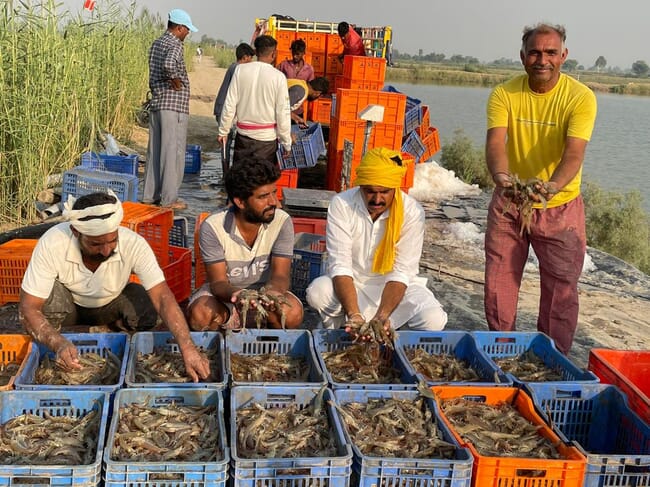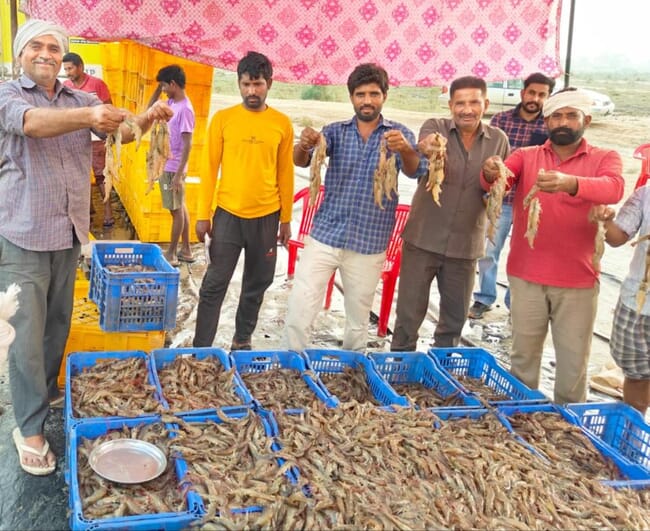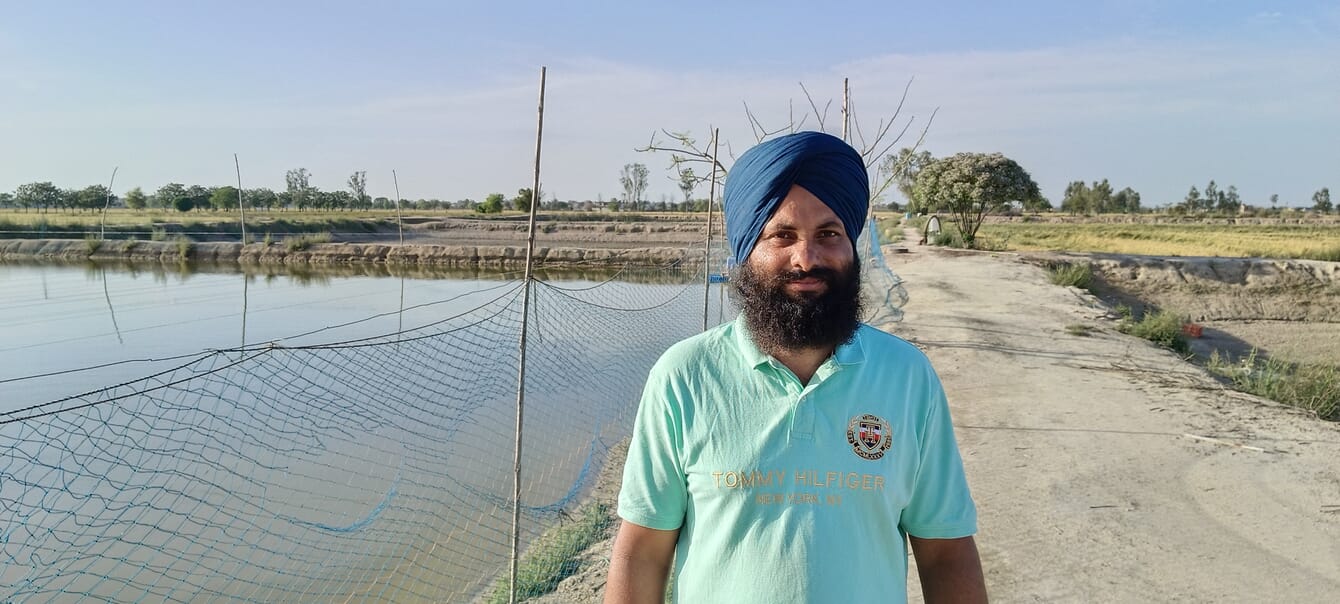
© Dr Meera D Ansal
Saroop Singh is a shrimp farmer at a remote Ratta Tibba village in Sri Muktsar Sahib District of Punjab, around 400 kilometers from Delhi.
The 38-year-old has been involved in vannamei shrimp farming since 2017 and produces around 45 tonnes annually from his 6 hectares of ponds.
Although the state is landlocked it is home to around 350 shrimp farmers, with a collective production of 2,500 tonnes annually, spread across 526 hectares.
“Unlike other Indian states of West Bengal, Andhra Pradesh and Odisha, we do not have any coastline. But we've still managed to do shrimp farming in areas where the water is salty. We tried several crops on this land but nothing worked as the ground water was salty and not fit for any type of cultivation. But shrimp farming has come as a blessing for us,” Singh explains.
Shrimp farming in Punjab is mainly restricted to five south-western districts – Sri Muktsar Sahib, Fazilka, Mansa, Bathinda and Faridkot – that are low-lying and have saline groundwater that is not fit for agriculture.
Dr Prabjeet Singh, deputy director of Krishi Vigyan Kendra (KVK), who has been hailed as one of the pioneers of shrimp farming in the state, says that 151,000 hectares of land in the five districts is unfit for traditional farming.
“The state government, along with Guru Angad Dev Veterinary and Animal Sciences (GADVASU) where I was formerly attached, started trials of shrimp farming in 2014 and 2016 in the villages here, which was very successful. Buoyed by the success, the state government began to encourage farmers to start shrimp farming commercially. The aim was to convert the zero earning land into a productive source of livelihood for farmers,” says Dr Singh.

© Dr Meera D Ansal
According to Dr Singh, many experts believe that the Green Revolution could have resulted in the high salinity.
“During the 1960s, the government focused on increasing crop production, which resulted in the massive use of chemical fertilisers. These five districts were low-lying areas and this could have resulted in the deposit of salt but it could be just one of the reasons. Farmers do not use ground water but prefer to use canal water for irrigation purposes,” he notes.
Whatever the reason some local farmers have benefitted.
“We are happy that shrimp gives us manifold income than traditional crop farming. Our production cost is around Rs 230 ($2.75) per kg and we sold the produce at almost double the price in 2022 when the demand was very high. We stock seed in April and harvest by November. There has been no outbreak of diseases here so far,” added Saroop.
The state government offers a subsidy of up to 60 percent for new shrimp producers.
“We offer subsidies for digging ponds and providing seed and feed to first time farmers. The seed is generally procured from Andhra Pradesh,” points out Jasvir Sharma, director of fisheries, Punjab.

© Gurvinder Singh
Challenges to the sector
However, despite significant success, many farmers complain that they are grappling with numerous issues that have been discouraging them from continuing in shrimp farming.
“Shrimp farming is a profitable venture but we urgently need a processing unit so we don’t have to sell our produce right after the harvest at a lower price. We are privately constructing the unit along with some farmers but need the financial support of the state government to complete the project,” explains Rupinder Pal Singh, 35, a shrimp farmer in Jandwala Charat Singh village.
Rajveer Singh, 28, a young farmer and trader also pointed out that the exports to countries like USA and China that are the major consumers of shrimp have been badly hit, due to growing competition from Ecuador – whose shrimp exports have been growing significantly in the last five years.
“The USA is a major market for India but we are facing strong competition from Ecuador, as it is providing shrimp at a lower cost. This has not only led to the decline in demand but has also been demotivating farmers from continuing. The situation has reached such an extent that farmers are forced to sell their produce for even less than the production cost because of lower demand and a lack of processing units,” he observes.

© Rupinder Singh
According to a recent report, India witnessed a 12 percent reduction in shrimp export volumes to the US between September 2021 and 2022, which Ecuador enjoyed a rise of 11 percent during the same period.
India is still expected to see a surge of 5 percent revenue growth in shrimp exports in the current financial year but that has been due to a strong demand by China, whereas it is still facing a strong competition in the USA from Ecuador.
Dr Meera D Ansal, dean of the College of Fisheries in Punjab, conceded that Punjabi shrimp farmers are losing enthusiasm.
“Ecuador surpassed India in 2021 in shrimp production, which affected India’s shrimp export to its biggest importer US and farmers in Punjab suffered huge losses in 2022 due to the shrimp price crash. Annual production is just not enough to set up a commercial scale processing unit in the state, while small scale processing-cum-storage units can be established in public-private partnerships to support the sector,” she argued.
“Like the Coastal Aquaculture Authority (CAA) of India for regulating aquaculture in coastal areas, a similar authority needs to be enforced for monitoring aquaculture development in inland saline areas in an eco-responsible and equitable manner. Further, shrimp farming should only be promoted in zero earning salt-affected degraded lands and not in fertile agriculture land by extraction of deep underground saline water, which may lead to salinisation of adjoining fertile lands and affect livelihood of farmers cultivating those lands,” she added.
Dr Ansal further conceded that shrimp consumption remains relatively low in this part of country and argues that it is essential to educate the local population about the nutritional qualities of shrimp to counteract export losses.




